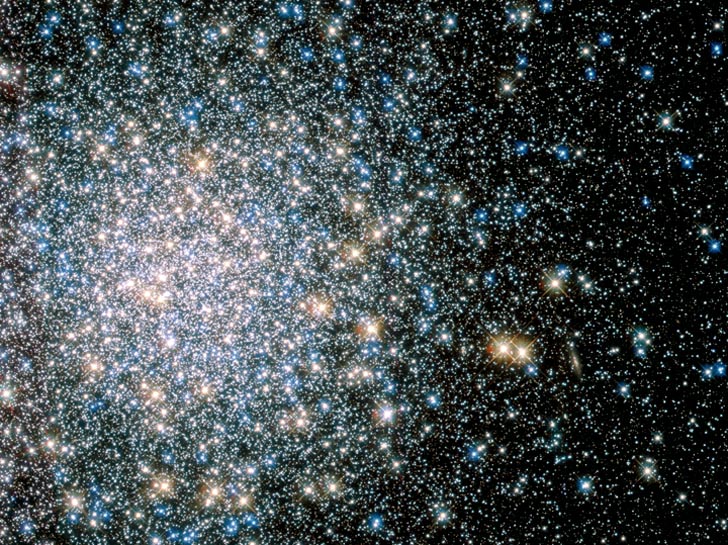
Description: Globular Star Cluster
Position (J2000): RA 15hr 18m 33.22s Dec +02° 04' 51.7"
Constellation: Serpens
Visual magnitude: +6.65
Apparent dimensions: 23 arc min
Distance: 25000 light years
Image Credit: ESA/Hubble & NASA
Release date: April 21, 2014
Full view: S1118
ABOUT THIS IMAGE:
This sparkling jumble is Messier 5 - a globular cluster consisting of hundreds of thousands of stars bound together by their collective gravity.
But Messier 5 is no normal globular cluster. At 13 billion years old it is incredibly old, dating back to close to the beginning of the Universe, which is some 13.8 billion years of age. It is also one of the biggest clusters known, and at only 24 500 light-years away, it is no wonder that Messier 5 is a popular site for astronomers to train their telescopes on.
Messier 5 also presents a puzzle. Stars in globular clusters grow old and wise together. So Messier 5 should, by now, consist of old, low-mass red giants and other ancient stars. But it is actually teeming with young blue stars known as blue stragglers. These incongruous stars spring to life when stars collide, or rip material from one another.
From Wikipedia:
Messier 5 or M5 (also designated NGC 5904) is a globular cluster in the constellation Serpens. It is, under extremely good conditions, just visible to the naked eye as a faint "star" near the star 5 Serpentis. Binoculars or small telescopes will identify the object as non-stellar while larger telescopes will show some individual stars, of which the brightest are of apparent magnitude 12.2.
M5 was discovered by the German astronomer Gottfried Kirch in 1702 when he was observing a comet. Charles Messier also noted it in 1764, but thought it was a nebula without any stars associated with it. William Herschel was the first to resolve individual stars in the cluster in 1791, counting roughly 200.
Spanning 165 light-years in diameter, M5 is one of the larger globular clusters known. The gravitational sphere of influence of M5, (i.e. the volume of space in which stars are gravitationally bound to it rather than being torn away by the Milky Way's gravitational pull) has a radius of some 200 light-years.
At
13 billion years old, M5 is also one of the older globulars associated
with the Milky Way Galaxy. Its distance is about 24,500 light-years from
Earth and the cluster contains more than 100,000 stars, as many as 500,000
according to some estimates